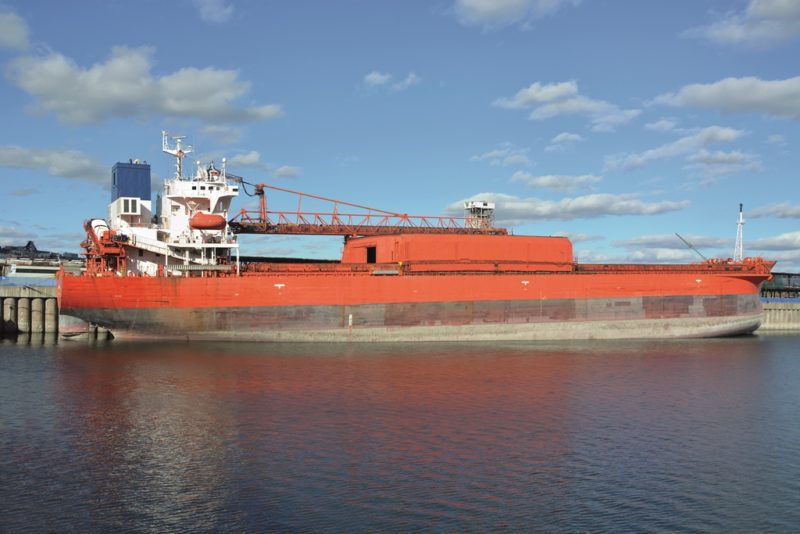
Montréal is a mainly French speaking large seaport with a total traffic of over 40 million tonnes of imports and exports per year. It is known as the ‘Gateway to the Great Lakes’ with both the smaller and older Lachine Canal and the modern St. Lawrence Seaway beginning at Montréal for access to Lake Ontario and on to the other Great Lakes. The French explorer Jacques Cartier navigated the narrow St. Lawrence river here in 1535, with the first French settlers arriving on 17th May 1642 to found Ville-Marie, now Montréal. Paul de Chomedey de Maisonneuve and forty French settlers arrived and built a small colony on Ile de Montréal. Small sailing ships began to dock along the extensive shoreline, overcoming the strong Sainte-Marie rapids, where the current Jacques-Cartier Bridge is located. Ships also unloaded their cargoes on Ile Normant, which was then transported to the town by merchants. Montréal is named after Mount Royal, the triple peaked hill in the heart of the city.
The Native American Huron people acted as pathfinders, guides and trappers for the French, with the French Army building up a considerable presence. The British were not going to allow France to dominate both Canada and the United States even as far down to the southern American area of Louisiana. The Royal Navy raided French coastal forts, French troops attacked British garrisons and trading posts. The issue was finally settled in the Seven Years’ War of 1756 to 1763. In 1759 on the Plains of Abraham, General James Wolfe and his troops routed a French Army under the Marquis de Montcalm and seized Quebec. Montréal capitulated on 7th September 1760, and as the British refused the honours of war to the French troops, those in Montréal and nearby Fort Levis burned their flags. The Huron people signed a separate peace treaty with the British on 5th September 1760.
The uneasy peace was soon shattered by the American War of Independence. The Canadian colonies remained loyal to Britain and fought off threats to both Quebec, Halifax (NS) and Montréal, but Montréal fell temporarily to the American colonists in 1775. When the war ended a year later, Britain and newly formed United States of America agreed to a very long straight boundary between Lake Superior and British Columbia in Canada, and the U.S.A., known as the ‘49th Parallel’.
JOHN YOUNG, FATHER OF THE PORT OF MONTREAL
In the Vieux Port (Old Port) of Montreal in front of Allan House at 333 De la Commune Street West, in the centre of the docks area, sits a bronze statue of John Young with the following inscription ‘Montréal has become the national port of Canada through the foresight, public spirit and energy of John Young’. He is known as the ‘Father of the Port of Montréal’, and had arrived in Montréal at the age of 19 years from Scotland, working as an import and export shipping clerk. A few years later he became one of the most influential of Montréal businessmen, and was appointed Chairman of the Harbour Commission in 1853, a position he held until 1866. During this period, the Harbour Commission concentrated on improving the accessibility and efficiency of the port and of the Lachine Canal, opened in 1825 to bypass the dangerous Lachine Rapids between the port and Lake Saint-Louis. The Lachine Canal was expanded twice in the 19th century and played an important part in the development of the Great Lakes, but was closed to commercial shipping in 1970, having been replaced by the St. Lawrence Seaway at the end of March 1969. The great achievements of John Young were as follows:-
- He dredged a deeper channel in the St. Lawrence river to allow larger ships to reach Montréal.
- He built many of the present day quays in the Vieux port.
- He reorganised the customs posts and methods.
- He widened the Lachine Canal to a width of 14.6 metres, depth of 1.4 metres, and of total length of 13.4 kilometres.
- He introduced rail access into the port areas.
- He built the Victoria Bridge to extend the railway from the south shore to the port on the north shore.
- He extended the Port of Montréal from the Lachine Canal to the Hochelaga wharf in the east, with rail access having been installed there for seven years in 1860. Some 259 ocean going sailing ships and steamers arrived in 1860, but with a massive increase to 574 ships in 1861.
The Harbour Commission had been created in 1830 by the Montréal Trade Board (now the current Chamber of Commerce) to expand and improve the port, and to construct permanent wharves and a flood retaining wall, pressing the Dominion Government to pay for the dredging of the river. The new port wharves extended to a length of one kilometre in 1832, and as an incentive for the first ocean going vessel to reach Montréal in early April after the winter ice-up, a Top Hat was awarded in 1840 to the Master of the first ship to arrive. This would be later replaced by a gold headed ‘Walking Cane’ around 1880, and was a similar cane to that presented to the Master of the first ship to arrive at Churchill in Hudson Bay.

Four years of major dredging work ended in 1854 to allow the passage of larger vessels to the port, with the channel between Quebec and Montréal dredged to a depth of 4.9 metres and a width of 76.2 metres. The first Allan Line ship arrived in the port in 1856 to begin a regular shipping service between Liverpool and Glasgow to Montréal. Hugh Allan was a Scottish born businessman who later settled in Montréal and lived in a large house along the river as one of many shipping line owners that made up the maritime community of Montréal, and far larger than that of Quebec. The Victoria Bridge opened in 1859 as the first link with the South Shore and was the longest rail bridge in the world at 2,790 metres at the time of its opening.
The St. Lawrence river remained blocked by thick ice for four months of the year, and it was only after the building of the Mackay stone trench boundary wall in the river in 1898 that blocks of ice could be kept clear of the wharves of the port. Steamers and sailing ships docked at wharves laid out parallel to the Rue de la Commune. The length of the port was divided into equal length ‘sectors’ or ‘sections’ numbered from one to 120, with the shed and wharf in each sector generally known as a ‘pier’. The different trades and destinations of import and export cargoes were allocated to separate ‘sectors’ and ‘piers’. Further major dredging work between 1883 and 1885 increased the width of the channel from Quebec to 90 metres and a depth of 7.5 metres.
The first Canadian Transcontinental train left Dalhousie Station in Montréal on 28th June 1886 for Vancouver, to improve the transport infrastructure of the country via the Canadian Pacific Railway and the Grand Trunk Railway. The Port of Montréal then gained three important basins in Basin 1, Basin 2, and Basin 3 with the Alexandra Wharf (built between 1899 and 1901 in Basin 1), King Edward Wharf (built between 1901 and 1903 in Basin 2), and the Jacques Cartier Wharf (built between 1898 and 1899 in Basin 3). The modern appearance of the port began to take shape. These three iconic concrete wharves were equipped with four permanent rivetted steel raised ‘hangars’, where cargo was stored well above the water level of the river. They form part of the ‘Grande Quai’ cruise berth today, with many shops and tourist restaurants for the mega cruise ships that call at Montréal.
A favourite day trip for residents of Montréal was to take the early morning train from Montréal to Prescott, 130 miles away, and then board one of three Canada Steamship Lines (CSL) special rapids steamers with wooden sheathed keels to prevent damage from the rocks, and ‘shoot the rapids’ all the way home to Montréal. Rapids King of 1,563 and built in 1907, Rapids Prince of 1,314 grt and built in 1910, and Rapids Queen of 770 grt and built in 1892, gave an exhilarating return voyage with engines stopped during the steep descent of the Long Sault Rapids of 45 feet over 9 miles, and the Lachine Rapids of a drop of 56 feet in less than 2 miles. Passengers would congregate on the bows of this trio, the men in Panama hats and cloth caps, and the women in warm clothing, to feel the power of the river as the trio of steamers bumped their way down over the rocks. The trio of steamers were moored overnight at the Victoria Pier in Montréal, which was the outward wharf of the very high Cold Storage Warehouse of considerable height topped with four stone towers, and having the Memorial Clock Tower at one end to commemorate the seafarers of the Merchant Navy that were lost during World War I. The plans of this iconic building were drawn up by Montréal engineer Paul Leclaire in 1914 but it was not completed until 1922.
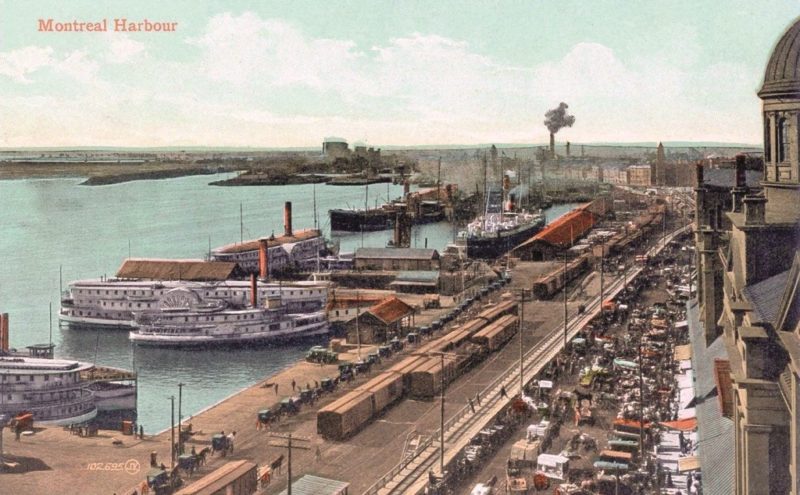
The nine floors of the immensely high Cold Storage Warehouse were for the cold storage of meat, cheese, fruit, vegetables, fish, and other perishable goods. Cooling was provided by calcium chloride brine being drawn down to very low temperatures through the expansion of anhydrous ammonia. A neighbouring building housed the refrigeration plant, which produced the electricity needed for the compressors. Electrical power was also needed to provide five tonnes of ice daily, and for the tractive power of nine new port electrically powered locomotives.
During the first decade of the 20th century, five very high grain silos were built in the port, with the first modern silo known as Elevator ‘B’ completed in 1902 to receive Western Canadian grain transported in long freight trains to Montreal and exported by ship to Europe and the rest of the world. Elevator ‘2’, completed during 1910/12, was the highest structure in Montréal and was the first silo to be built of reinforced concrete in the world, and stood in front of the Bonsecours Market. It doubled the capacity of the Port of Montréal to export grain until it was demolished in 1978. Elevator ‘3’ was completed in 1923 and has since been demolished, Elevator ‘4’ is in use as the Viterra Grain Terminal, and Elevator ‘5’ was the last of these colossal grain elevators and expanded in stages until 1958 and was ultimately shut down in the winter of 1994. It stands unused within the Vieux Port near the Bickerdike Terminal in the Bassin Pointe du Moulin until a future is determined by the people of Montréal in its iconic location. The grain export trade doubled in size between 1910 and 1920, with the Port of Montréal becoming the biggest grain port in North America in 1926, exporting 135 million bushels of grain, which explains why five huge elevators were needed to be built. The next largest grain exporting port in the Americas was New York with only 75 million bushels exported in 1926. The Port of Montréal exported its record highest tonnage of grain in 1930, but today, only elevator ‘4’ is still in use as the Viterra Grain Terminal, exporting huge amounts of grain stored in 350 separate silos with a storage capacity of 262,000 tonnes, and a handling rate of 5,500 tonnes per hour.
The Jacques Cartier Bridge opened in 1930 to vehicle traffic, but the difficulties presented by the Great Depression were felt in the port up to 1935, leading to a sharp fall in total cargo traffic, and in the major grain trades and markets. The Federal Department of Transport was created in 1935, and a year later the National Harbours Board of Canada was created, thus abolishing the Port Harbour Commissioners of Montréal. The new board administered all Canadian ports, as well as the first Canadian airline, Trans-Canada Airlines, later Air Canada, for air transportation. The Harbour Commissioners twin screw tug Sir Hugh Allan of 354 grt, completed by Vickers Ltd. in Barrow in July 1911 of length 130.0 feet and beam of 26.6 feet, had steam engines built by Vickers and also came under the new National Harbours Board of Canada in 1936.
THE PORT OF MONTREAL IN POST WWII YEARS
The port had recovered by 1947 from the shortages of commodities and reduction of trade from Canadian registered vessels requisitioned for war duties. Canada Steamship Lines (CSL) was then the biggest Canadian shipping company, and after giving up passenger transport on the St. Lawrence in 1967 and its iconic ‘hurricane deckers’, it moved into an equally dominant position with bulk cargoes. There were 25 British and European shipping companies trading to the port in 1947 carrying passengers and cargo during the eight months ‘open’ ice free season. The facilities of the port at this time and in the first part of the 1950s were as follows, starting with the most up-river facilities and working downstream:-
Bickerdike Pier
Windmill Point Basin
Entrance to the Lachine Canal
Alexandra Pier
Basin 1
King Edward Pier
Basin 2
Jacques-Cartier Pier
Basin 3
Marine Tower Jetty
Victoria Pier and Cold Storage
Warehouse
Market Basin
Wharves 1 to 5 and Piers 20-33
North Shore, South Shore and Newfoundland trades (Piers 34 and 35)
Laurier Pier
Tarte Pier
Sutherland Quay
Canadian Vickers Ltd. shipbuilding yard with floating dry dock for repair work (Piers 50-60)
Coal Dock
Vulcan Wharf (Pier 71)
Longue Pointe Wharves (Piers 75-85)
Canada Cement Company (Pier 97)
McColl-Frontenac Oil Company (Piers 98,99)
Imperial Oil Company (Pier 101)
Shell Oil Company (Pier 103)
Sun Oil Company (Pier 104)
British American Oil Company (Pier 105)
Marien Street Wharf (Pier 110)
Pointe Auxiliare Trembles Wharf (Pier 115)
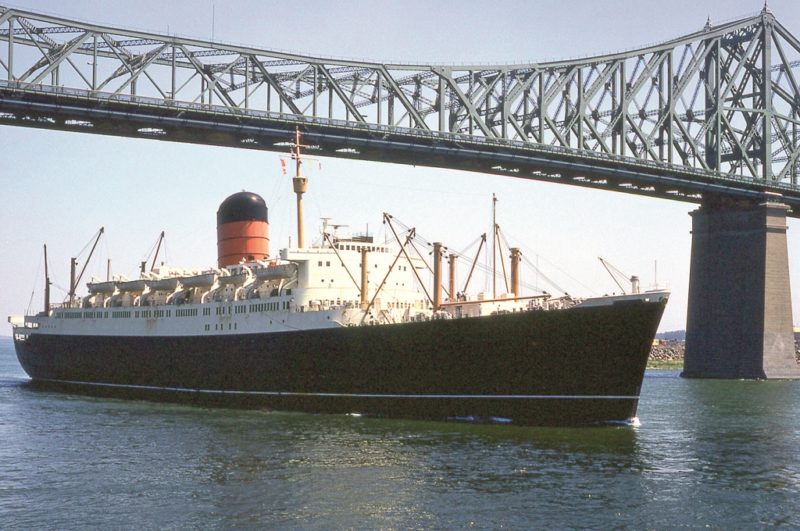
The opening of the St. Lawrence Seaway on 1st April 1959 as the largest penetrating waterway on any continent, has enabled deep sea ships of many nations of the world to enter the Great Lakes trades. The construction of seven locks between Montréal and Kingston, starting with the St. Lambert entrance lock and the Cote Ste Catharine lock at Montreal was a major feat of engineering to lift ships 13.7 metres to bypass the Lachine Rapids to the level of Lake St. Louis. Together with eight other locks between Lake Ontario and Lake Erie to lift ships another 100 metres over the Niagara Escarpment, this took years of planning and construction. The joint venture St. Lawrence Seaway between Canada and the U.S.A. was completed for the ‘open’ season of ice free navigation in April 1959. Unfortunately, the Seaway allowed many vessels to by-pass the Port of Montréal and reduced the dominance of the port. The Lauritzen ice strengthened cargo ship Helga Dan was the first ship to reach the port during the ‘closed’ season in January 1964 after much ice clearance by Canadian Coast Guard icebreakers. Today, the Port of Montréal receives ships all year round with the help of powerful icebreakers.
The last Canadian Pacific passenger liner, Empress of Canada, had been completed on the Tyne at the Walker Naval Yard of Vickers-Armstrong Ltd. in 1961 and made her maiden voyage on 24th April of that year from Liverpool and Greenock to Quebec and Montréal. On 23rd November 1971, just over ten years later, she arrived back at Liverpool at the end of her last voyage from Montréal after 68 years of Canadian Pacific Steamships Transatlantic services. Canadian Pacific Railways (CP) had been partly funded by the Bank of Montreal, with construction of the long railroad to British Columbia begun in May 1881, and finally reached Port Moody near Vancouver five years later on 28th June 1886. The loss of the last passenger line at the Port of Montréal was eased four years later in 1975 when the first container ship services into the port began.
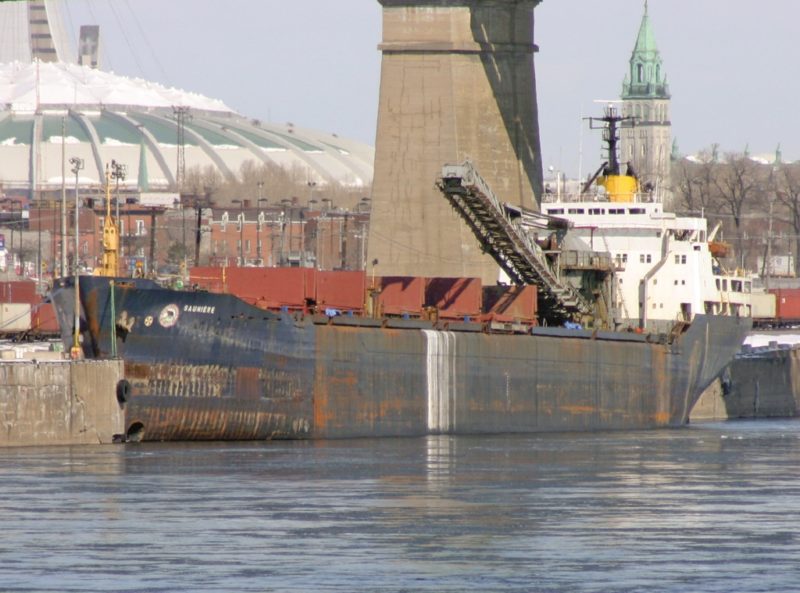
THE CURRENT PORT OF MONTREAL
The current port is located at position 45°32′ North and 73°31′ West, and is very busy and handled the arrivals and sailings of 2,525 vessels of 53.432 million gross tonnes during 2019, together with 112,000 cruise ship passengers and crew members, with cruise ships representing 17 major world cruise companies. The trade of the port is 41% container traffic, 24% dry bulk, and 35% liquid bulk, with the port having 4 container terminals, 14 bulk and breakbulk terminals, a grain terminal, and 11 liquid bulk terminals.
The Port Headquarters Office has 240 employees working in a modern ‘Z’ shaped building when viewed in aerial plan mode, covering information technology, water engineering, water services, electricity generation, electrical and mechanical engineering, finance, administration, communications and human resources. Some of the major terminals are now described:-
GRANDE QUAI CRUISE TERMINAL
The terminal has two berths for very large cruise ships located on De la Commune Street in the historic Old Vieux district, on the site of the former Alexandra Pier. The area was renovated in 2018 and has shops, restaurants and tourist amenities, and shore excursions are arranged to tourist sights on both the North Shore and South Shore, and to rustic fishing villages, for whale watching and longer trips to the United States of America. Montréal Cruise Terminal 3 is located at Pier 34, and the twin airports of Montréal Dorval International Airport, and Montréal Pierre Elliott Trudeau International Airport, are only twenty minutes away by road. The Grand Quay terminal has a huge and long main building covered with a green roof and terrace, and handles over 120,000 cruise passengers per year. The history, trades, and port facilities of the Port of Montréal are presented in a useful Interpretation Centre, and an Observation Tower has opened in 2021 with breath taking panoramic views over the river and the city.
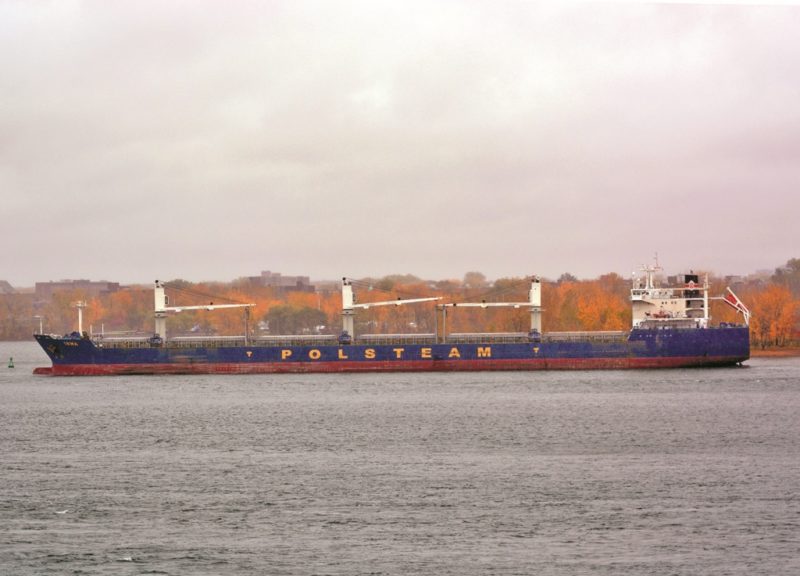
CAST CONTAINER TERMINAL
This terminal was originally built in the 1980s for Cast Lines and is of 30.8 hectares in area, and is operated by Montréal Gateway Terminals with a capacity of 800,000 TEU per year with the main users being Maersk Line, CMA CGM, MSC, CSAL, HMM Hyundai, OOCL, Hamburg Sud, Hapag Lloyd and COSCO. The terminal has three berths of total length 740 metres, 14 gantry cranes, 13 reach stackers, 420 electrical plug outlets, 84 diesel generators and can accommodate 120 rail wagons.
RACINE or ROOT CONTAINER TERMINAL
This terminal extends over 24.7 hectares and is known to French speakers as the Racine Container Terminal, and to English speakers as the Root Container Terminal. It is operated by Societe Terminaux Montréal Gateway, and the main users include Maersk Line, CMA CGM, MSC, CSAL, Hapag Lloyd, Hamburg Sud, OOCL, COSCO and HMM Hyundai. There are three berths with a total length of 770 metres, and the facilities include 14 gantry cranes, 13 reach stackers, 280 electrical plug outlets, 96 diesel generator sets, and it handles a capacity of over 500,000 TEU of containers per year.

MAISONNEUVE CONTAINER TERMINAL
This terminal was originally the Manchester Liners container terminal of the 1980s and extends over an area of 25.0 hectares, and is very similar in facilities and capacity to the Racine or Root Container Terminal. It is operated by Termont Terminals of Montréal and is mainly used by Maersk Line, Hapag Lloyd, MSC and OOCL. Some 120 rail wagons can be accommodated on the terminal to take containers directly from the cranes.
VIAU CONTAINER TERMINAL
This is the newest Port of Montréal Container Terminal of area 38.4 hectares and was completed during 2016 and is operated by Termont Terminals of Montréal. There are three berths of total length 950 metres with a capacity of over 600,000 TEU per years and with the main user being Mediterranean Shipping Company (MSC). The big terminal has 21 gantry cranes, 50 reach stackers, 384 electrical plug outlets, with the concrete apron allowing 155 rail cars to load directly from the gantry cranes.
BICKERDIKE TERMINAL
This revamped terminal was originally one of the first piers of the old port, but now is of 9.6 hectares in area, with two berths of a total length of 357 metres, two gantry cranes handling 40 ft. containers, nine reach stackers, several mobile cranes of 100 or 200 tonne capacity, 95 forklifts, 60 electrical plug outlets for refrigerated containers, and 100 electrical plug outlets for heated containers in winter. Empire Stevedoring of Montréal handle the general cargo, bulk and non container trades to Newfoundland and the Magdalen Islands, and the terminal has a ro-ro ramp to load all manner of wheeled cargo.
K+S WINDSOR SALT TERMINAL
This a major installation at Pier 37 for the recovery, processing and marketing of over two hundred mostly salt based products e.g. granulated or evaporated salt products, and used in a whole variety of modern foods and commodities.
LANTIC SUGAR TERMINAL
This large sugar terminal unloads via conveyor belts bulk carriers transporting raw sugar from Brazil, India, the West Indies and other world ports, which is then refined in this sugar refinery to be exported via conveyor belt back to waiting bulk carriers, or to be used in Canada.
CAN EST SOYABEAN TERMINAL
This terminal at Pier 31 is operated on the site of the former grain elevator ‘3’ erected in 1923, and which was demolished and the site rebuilt with a new, white painted soyabean terminal in 2017, when soyabeans dethroned grain volumes at Montréal. The changed market sees a buoyant demand for soy milk, tamari sauce, miso soyabean soup, edamame boiled and salted fresh green soyabeans, tofu curd made from mashed soyabeans, and tempeh which are firm, chewy ‘cutlets’ with a mild, nutty flavour used in place of meat in third world countries. Large areas of pristine forest in Brazil, Indonesia and other countries with rainforest jungles have been cleared and used instead for growing soyabeans. Bulk carriers arrive at Can Est, with 60% of the cargoes are soyabeans (800,000 tonnes), and only 40% are grain cargoes. After processing into the various soyabean type products, some 6,000 TEU of containers of soyabean products leave the terminal every week for China, Vietnam, Indonesia, Malaysia and other South East Asia countries. This is a major revolution in eating habits, with shelves of supermarkets stocked with new and wonderful soyabean products.
VITERRA GRAIN TERMINAL
This large grain terminal at Pier 55 is operated by Viterra Grain on the revamped Elevator ‘4’ with its many separate silos each holding 4,000 tonnes of grain. This gives a grain storage capacity of 262,000 tonnes with a loading or unloading rate of 5,500 tonnes per hour into bulk carriers. There are two berths (54/55 and 56) with a total length of 640 metres, and it is the most efficient grain elevator on the St. Lawrence with imported or transhipped cargoes discharged into convoys of 110 rail wagons at a time. Grains handled include wheat, corn, barley, soya beans, dry peas and canola.
LOGISTEC ARRIMAGE INC.
Quebec Terminals Inc. was set up in 1952 as a general purpose import and export quay, founded by Roger Paquin, who grew up in Trois Rivieres, and became familiar with longshoremen and their methods of loading and unloading ships. He brought into the St. Lawrence in 1964 Lauritzen icebreaking cargo ships to keep his clients moving during the long four month ‘closed’ season. He formed Termont Terminals in 1988, and ten years later expanded into specialist watermain services. The most important container client for Termont Terminals is MSC, a partnership begun in 2006.
TERMINAL NORCAN INC.
Pier 74 is used by Norcan as a logistics hub bringing together all of the many organisations in Montréal and Quebec Province that use containers in any mode of use.
CANADIAN PACIFIC (CP) & CANADIAN NATIONAL (CN) RAIL TERMINALS
The rail yards of these two giant Canadian rail networks are in constant use at the Port of Montréal, with the formation of long freight trains to be loaded or unloaded for country wide destinations.
VOPAK OIL TERMINAL
Royal Vopak of Holland have a liquid bulk terminal in the north of the port handling petroleum products, chemicals, gases, molasses, vegetable oils and other liquid cargoes with a storage capacity of 2.6 million barrels of oil. There is a single wharf of length 238 metres.
SUNCOR OIL TERMINAL 1
This is the larger of two Suncor Oil terminals with a storage capacity of one million barrels of oil. The terminals remove sulphur and sodium bisulphite from crude oil imports, and produces petroleum products for agricultural use and in wastewater treatment and management of sewage sites.
SUNCOR OIL TERMINAL 2
This the smaller of two Suncor Oil terminals with a storage capacity of 130,000 barrels of cruse oil, and performs the same functions as Suncor Oil Terminal 1, with a wharf of 406 metres in length.
VALERO ENERGY TERMINAL
Crude oil and refined petroleum products are used throughout Quebec, Ontario and U.S. States from this terminal, reaching them by pipeline, coastal tankers, and rail oil wagons. This the biggest oil terminal in Canada with a storage capacity of over five million barrels of crude oil and refined products.
SHELL OIL CANADA TERMINAL
This Shell liquid fuels terminal has a storage capacity of four million barrels of crude oil and refined products, with the site having very high environmental standards in terms of reduced industrial accidents.
NON CONTAINERISED GENERAL CARGO and OTHER BULK CARGO
There are several berths and open areas for handling general cargo that are not containerised. There are also several other bulk handling berths not mentioned above for the handling of iron ore, fertilisers, rock salt, copper ore, raw sugar, gypsum, aggregates, and zircon sand and other industrial sands.
The Intermodal Rail Exchange Area of the Port of Montréal takes convoys of double height container rail wagons directly from the quays without the containers being touched by stackers or dumped to ground. The rail convoys are then transported by port locomotives to the rail exchange area of Canadian National and Canadian Pacific Railways. Containers can be switched inter modally to or from trucks arriving at the exchange area. The road truck entrance gates are equipped with CCTV, and optical recognition systems, at 27 checkpoints throughout the port to give automatic registration and making collections and deliveries to the port by road simple and secure. Security clearance for port passes for port employees are handled by the Office.
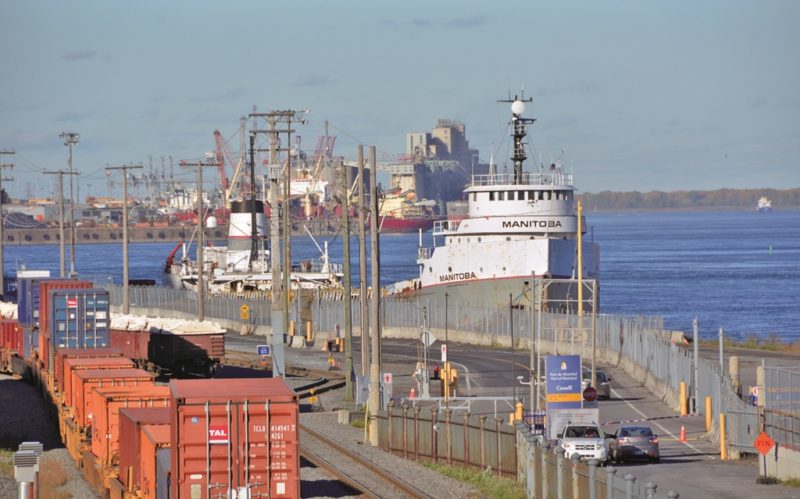
CANADIAN-VICKERS Ltd. SHIPBUILDING YARD
A large shipyard began to be constructed in June 1911 between Rue Notre Dame and Rue Via in the Maisonneuve district of Montréal in the centre of the long line of wharves that stretched for over a kilometre. Vickers Sons and Maxim of Barrow first began to investigate the possibility of a repair yard here four years earlier, and the Canadian Government offered land suitable for five building berths of 600 feet in length, later extended to 750 feet and more than adequate for the 270 ships built up to 1971, including nine bulk carriers of 28,000 dwt completed between 1958 and 1968. The yard made Montréal a major Canadian shipbuilding port, and the site is now occupied by the Viterra Grain Terminal, the ships having been launched parallel to the shore between two long arms that are still extant today.
A large floating dock of 25,000 tonnes lift capacity was ordered for repair work, which was opened in 1912, with construction of the first submarines, ten Holland 602 types for the Royal Navy, began in the middle of 1914 with the first submarine in service in May 1915 as H1, followed by H2, H3, H4, H5, H6, H7, H8, H9, and H10. A further eight submarines were completed for the Italian Navy and six for the Russian Navy, both allied to the Royal Navy at this time. ‘Battle’ class trawlers were also designed and built for the Royal Canadian Navy (RCN) including HMCS Armentieres. A big programme of 43 minesweepers was completed for the Royal Canadian Navy (RCN), as well as an icebreaker and a dredger for the Canadian Government. War ‘B’ type general cargo ships were built during World War I, with 23 vessels completed for the Canadian Government and the Shipping Controller in London. The last of these was not ready until July 1921, and they took their first voyages as Canadian Voyageur, Canadian Pioneer, Canadian Ranger, Canadian Seigneur, Canadian Miller, Canadian Spinner, Canadian Planter, Canadian Navigator, Canadian Victor, Canadian Conqueror, Canadian Commander, Canadian Leader, Porsanger, Samnager, Rosyth Castle, Baldina, Cape Premier, Vittorio Veneto, Tatjana, Loch Tay, Alsace, Idefjord and Topdalsfjord.
The company had nine directors in 1920 with the President being Sir Frederick Orr-Lewis, the other directors being Sir Trevor Dawson, Sir Vincent Caillard, Sir Francis Barker, Sir James McKechnie, A. R. Gillham (Managing Director), J. G. Lewis. J. W. Norcross and Preble Macintosh. The maximum annual output during World War I was 70,000 tonnes of ships, later increased to 100,000 tonnes in World War II. During the inter-war years, some 23 vessels were completed, including icebreakers, fisheries patrol vessels, dredgers, hoppers, tugs, barges, lighters, caissons and the large salvage tug Foundation Jupiter of 466 grt completed in August 1928 and wrecked while under tow off Newfoundland from the St. Lawrence in the 1940s.
In June 1919, yard workers led strike action in Montréal as part of larger strike actions within the Canadian shipyard industry demanding a maximum of eight hours per working day. Eventually, this reasonable demand was granted, after Vickers merged with Armstrong Whitworth of Newcastle to form Vickers-Armstrong Ltd. The Montréal Dry Dock led by Frank Ross and two of his business partners in 1926 began negotiations for a merger with the yard, with six months of talks agreeing to the merger in November 1928. During the Great Depression, the yard survived by making steam turbines, structural steel, and other subsidiaries were formed for the construction of aircraft at a site at Cartierville Airport in Ville Saint Laurent to the north west of Montréal. Rail cars were also built at the yard in post WWII types including MR-63 railcars for the Montréal Metro when the ship order book began to fall temporarily.
The very large warship programme for the Royal Canadian Navy (RCN) and the Royal Navy in World War II, included eight ‘Flower’ class corvettes, 26 frigates, six minesweepers, and 15 landing craft, many of this total used in the Normandy D-Day landings of 6th June 1944. Four large destroyers were built for the Royal Canadian Navy during the early 1950s as HMCS St. Laurent, HMCS Ottawa, HMCS Restigouche and HMCS Mackenzie. Two large icebeakers for the Canadian Coastguard were completed as CCGS Louis S. St-Laurent and CCGS Simcoe to complete the Government programme.
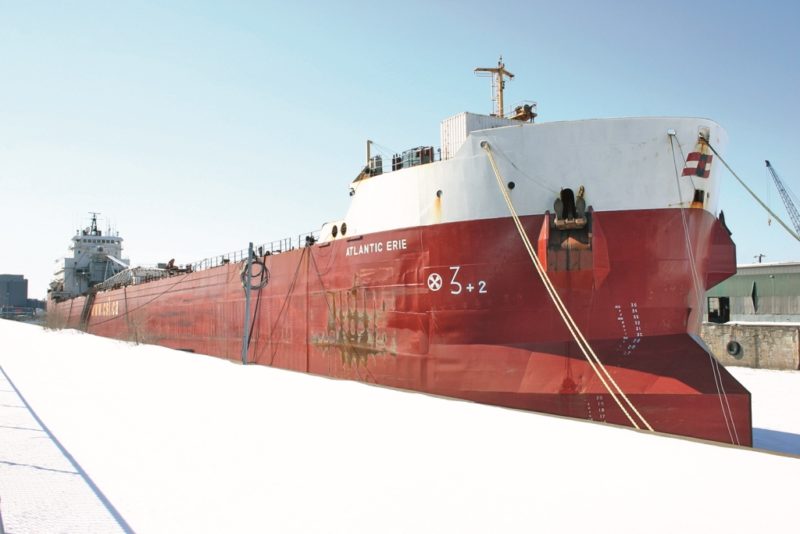
Merchant ship production after 1945 included ten general cargo ships for Lloyd Brasileiro of Brazil, eight ‘Canallers’ for the Hall Corporation of Canada, eight general cargo ships for French and Colombian owners, six coasters of 588 grt for C. A. Venezolana de Navigation, buoy tenders, lightships, research vessels, tugs, trawlers, ferries, barges, scows, and the passenger and cargo vessel Federal Maple of 3,196 grt in August 1961 for the West Indies Shipping Corporation. A large floating dry dock was completed in October 1965 for its own use and is still in service today as Scotia Dock II.
The research ship Baffin of 3,460 grt was completed in 1956 for the Hydrographic Service of the Canadian Department of Mines and Technical Surveys for surveying in the Arctic. She was a twin screw motorship powered by four Fairbanks Morse diesel engines through two oil operated twin engine reverse reduction gears to give a service speed of 14.5 knots. She had dimensions of overall length 285 feet, moulded beam of 49.8, and loaded draft of 16.6 feet, with a helicopter deck aft, eight lifeboats, and twin derricks over the forward hold.
The yard owned three floating docks in 1973, and large equipment for prefabrication work included a 700 tonne gap press and a 36 feet long roll press for curved sections. Nine bulk carriers of 28,000 dwt were completed during the ten years from 1958 to 1968 as Alexander T. Wood, Avery C. Adams, John A. France, J. N. McWatters, Quebecois, Don de Dieu, Maplecliffe Hall and Ralph Misener for Great Lakes trades. The last ships completed by the yard included the container ship Klondike of 8,043 grt in June 1969 and a scow in 1971.
The Montréal shipyard was re-acquired to full ownership by Vickers Ltd. in 1956, and was renamed Vickers Canada Ltd. in 1978 and sold off to Marine Industries Ltd. (MIL) as MIL Vickers Ltd. in 1987, and Versatile Vickers Inc. in 1981. Various contracts for land construction were carried out at the yard after the last ship was completed in 1971 with all work ceasing in 1988. One of the corvettes built during World War II later achieved fame in being converted into a luxury yacht for Aristotle Onassis of Greece for himself and his wife Christina and renamed as Christina O in 1954 and later renamed Argo. A large new luxury motor yacht was completed in 1967 by the yard as Club Atlantic, and the icebreaker Bart Roberts, built in 1963, was converted into a luxury yacht in 2001.
MONTREAL PORT TUGS
Ocean Groupe of Canada have been the main traditional providers of tugs in the Port of Montréal after acquiring the McAllister Brothers Inc. of New York subsidiary tug operation, McAllister Towing Ltd. of Montréal. This subsidiary owned six tugs and two barges in 1973, the tugs being Salvage Monarch 219/59, Salvage Prince 184/24, Daniel McAllister 288/07, Helen M. McAllister 152/59, Sinmac 224/58 and Mathilda 114/99. Danish owned Svitzer, part of the Maersk Line empire, brought in four tugs in competition in late 2016. However, loyalty to Ocean Groupe was so strong by port users that Svitzer decided to withdraw in July 2017 after a very brief period of operations, selling all of its assets to Ocean Groupe. There are four Ocean Groupe tugs in use today in the Port of Montréal of around 4,000 to 5,000 bhp, including Ocean Tundra, Ocean Taiga, Ocean Steyns, and Ocean Pierre Julien, the latter named after an employee and completed at the Ile aux Coudres in 2013 at the staggering cost of $10.6 million.
The Ocean Groupe tugs tow container ships to the four container terminals for Maersk Line, CMA CGM, MSC, CSAL, Hapag Lloyd, Hamburg Sud, OOCL, COSCO and HMM Hyundai. Bulkers such as Helga Bulker of Lauritzen, Nordrhone of Reederei Nord (Klaus E. Oldendorff), Federal Delta and Federal Yoshino of Canadian Fednav Bulkers, and CSL Laurentien of Canada Steamship Lines (CSL) bring in or export bulk cargoes. General cargo ships such as the Wagenborg ‘V’ class of Virginiaborg, Volgaborg, and the OCEANEX ro-ros of Oceanex Avalon, Oceanex Connaigra and Oceanex Sanderling, dock at the Bickerdike Terminal.
Tankers of up to 150,000 dwt e.g. Algoma Spirit, Algosea and Algoma Buffalo of Algoma Tankers Inc. serve the big refineries. Terminal Norcan receives smaller ships such as Juno Marie, Rosaire Desgagnes and Ferbec.
PORT OF MONTREAL NEW DEVELOPMENTS
CONTRECOEUR TERMINAL
A new 1.15 million TEU container handling terminal on the South Shore of the St. Lawrence and 25 miles from Central Montreal.
Supporting the growing container market in Eastern Canada with 5,000 construction jobs and a commissioning date in 2024.
- Two berths and a large container handling yard.
- An intermodal marshalling yard connected to the main rail network.
- A truck gate connected to the major Highway 30 motorway road network.
- Secondary facilities for other port users.
- A huge 468 hectares of land and four kilometres of shoreline on the south shore.
- Space for major industrial and logistics developments.
- Termont Terminals and MGT Terminals will be the site operators.
MONTREAL SCHEDULED CRUISE SHIP ARRIVALS IN 2022
Holland America Line 8
Seabourn Cruises 8
Royal Caribbean International 3
Carnival Cruise Lines 3
Oceania Cruises 3
Regent Seven Seas Cruises 3
Windstar Cruises 2
Viking Ocean Cruises 2
Hapag Lloyd Cruises 2
Phoenix Seereisen 1
TOTAL 35
POSTSCRIPT
The Montréal International and Universal Expo of 1967 lasted from April to October of that year and welcomed 50 million visitors to presentation displays and show sites of 62 countries at the Ile Sainte Helene and Ile Notre Dame.
The latter island was created in ten months using land spoil fill extracted from the tunnels being dug for the Montréal Metro system.
This was the largest worksite ever undertaken in Quebec Province over such a short period of time.
The Montréal Expos baseball team that played in the Canadian National League between 1969 until 2004, when they relocated to Washington (DC) to become the Washington Nationals, was named after the Expo.
The Montréal Summer Olympics of 1976 spared no expense, with a huge $1.5 million athletic stadium built from pre-stressed concrete.
Today, the rejuvenated Vieux Port of Montréal is a mecca for lovers of French cuisine with over five thousand restaurants having the tradition of French cuisine.
Gourmet lovers also flock to the French brasseries and cafes for lunches and dinners, and many of these allow their clients to bring their own wine, not a bad idea to attract clients.
The Vieux Port and the Lachine Canal National Historic Site had been declared as Heritage Sites in 1964 by the Government of Quebec.
Tourists in the city visit the blue ceilings with gold stars, gold icons, wall decorations, a gold detailed altar, and beautiful stained glass windows of the Notre Dame Basilica, designed by an Irish American and with the construction begun in 1823 of this 60 metre tall masterpiece.
The Cathedral Marie Reine des Coeurs was built for the Roman Catholic religion in 1894 and is the third largest cathedral in Quebec Province with a height of 76.8 metres, and was built in the baroque and renaissance architecture styles with an unusual white painted porch with a filial on top. St. Joseph Oratory on the top of Mount Royal is the largest church in Canada, with a huge green dome topping a very large greystone church, and illuminated at night. Cherrier Street and other streets have some magnificent grand houses with quirky roofs and great architectural merit.
There are two universities, and the city is a major financial centre today, with the economy including aerospace industries, electronic goods, pharmaceuticals, printing, software, telecoms, textiles and apparel, tobacco, oil and petrochemicals, shipping and tourism.
I wish to sincerely thank the excellent website of the Port of Montréal at www.port-montreal.com.

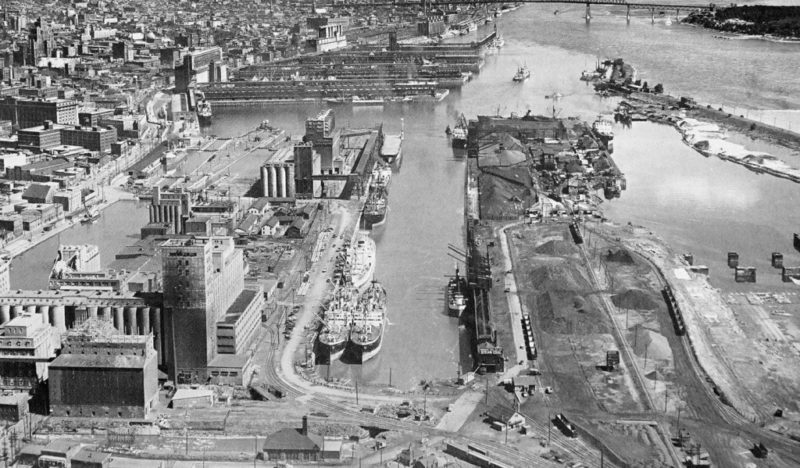
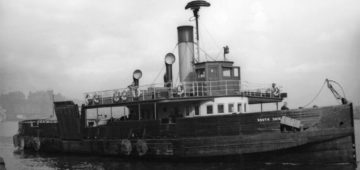



Comments
Sorry, comments are closed for this item